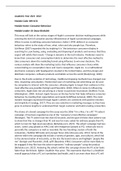Essay
(2:1 Graded) Consumer Behaviour Essay on Apple - Marketing Psychology
- Module
- Consumer Behaviour (BM1156)
- Institution
- Aston University, Birmingham (Aston)
(2:1 Graded) Consumer Behaviour Essay on Apple - Marketing Psychology, High quality and well detailed. It contains correct pictures and is incredibly well organised and put together in terms of structure and format. High-level research with a professional sense of the layout. This essay will loo...
[Show more]



